Ergonomic science established its core principles in the 1990s: lumbar-supported dynamic neutral postures (0° neck & 25-45° lower back curve) are the ideal for long periods of seated desk work. Over the past decade, esports performance coaches have prioritized the “dynamic” part: frequent movement, supported by adequate rest, nutrition, and exercise, helps players perform better. Recent studies further highlight movement as the ultimate lower back pain treatment.
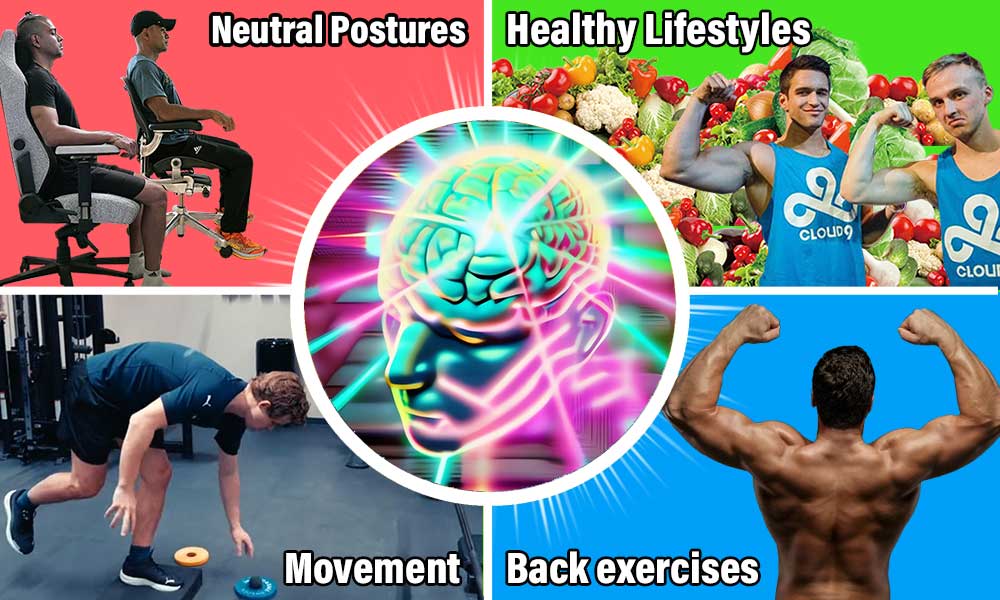
By combining neutral posture science, esports performance trends, and recent studies linking movement to musculoskeletal health, a clear blueprint emerges for optimal desk work. Here’s a summary of the most relevant performance trends for 2025 desk workers.
Trends in desk work and health
Several studies show a link between prolonged desk work and health issues, including fatigue, poor posture, and reduced cognitive function. A significant portion of the global workforce is affected. Key trends:
- Musculoskeletal disorders (MSDs) are normalized: An estimated 1.7 billion people globally, or 20% of the adult population, suffer from MSDs. Lower back pain is the most common disorder.
- Poor postures burn more energy: Fatigue from poor sitting postures has a significant negative impact on cognitive performance and mental energy.
- Medical treatments don’t work: Most traditional, doctor-prescribed treatments for lower back pain have been proven largely ineffective in the long term.
- Healthy lifestyles beat medicine: Studies show that esports performance techniques (like exercise, nutrition, and proper sleep) effectively reduce back pain and boost desk work performance.
- Best back exercises for good posture: Instead of relying on a chair, improve your core strength and posture in less than a month with beginner-friendly pull-ups, dead hangs, and hanging leg raises.
- Ergonomic chairs support neutral postures: Beyond neutral posture support, ergonomic chairs have minimal impact on desk work health.
- Walking breaks beat chair tilt functions: A comprehensive study found no evidence to support benefits from chair tilt functions. In contrast, short walking breaks have many proven benefits.
Poor posture drains energy and brain power
1. Musculoskeletal disorders (MSDs) are the norm
The WHO estimates that 1.7 billion people, or 20% of the global population, suffer from MSDs(1). Lower back pain is the most common disorder, affecting around 800 million people worldwide(2).
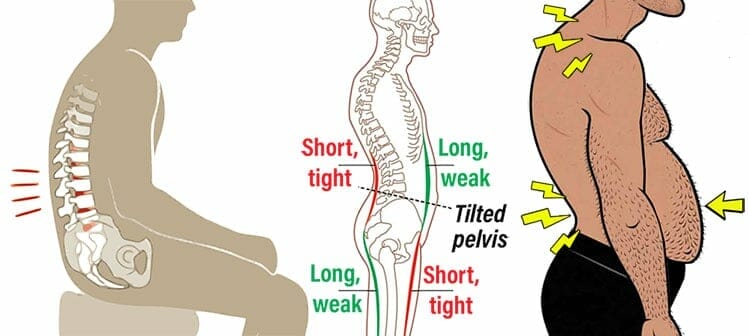
During seated desk work, MSDs are a major cause of physical and cognitive fatigue. For instance, one study found physical and mental fatigue as the third most prevalent MSD among Irish doctors.
2. Posture impacts energy and cognitive function
Fatigue from poor posture directly impacts mental performance. As stated by Nobel Prize recipient Dr. Roger Sperry, “The more mechanically distorted a person is, the less energy available for thinking, metabolism, and healing.”
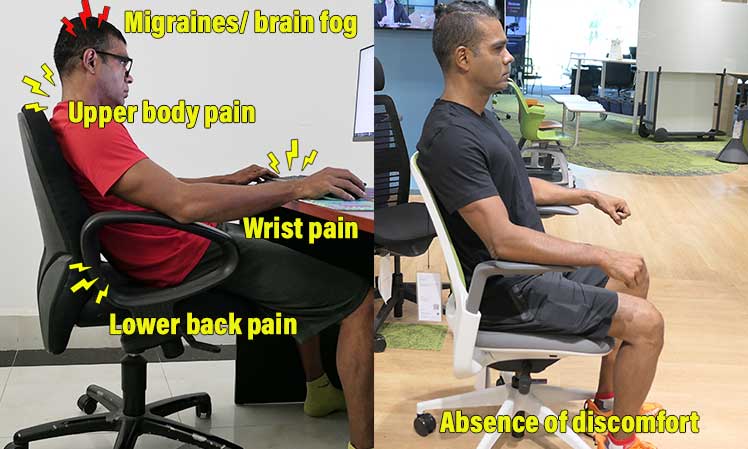
This is because a significant amount of the body’s energy is spent holding itself upright against gravity; a poor sitting posture uses up even more.
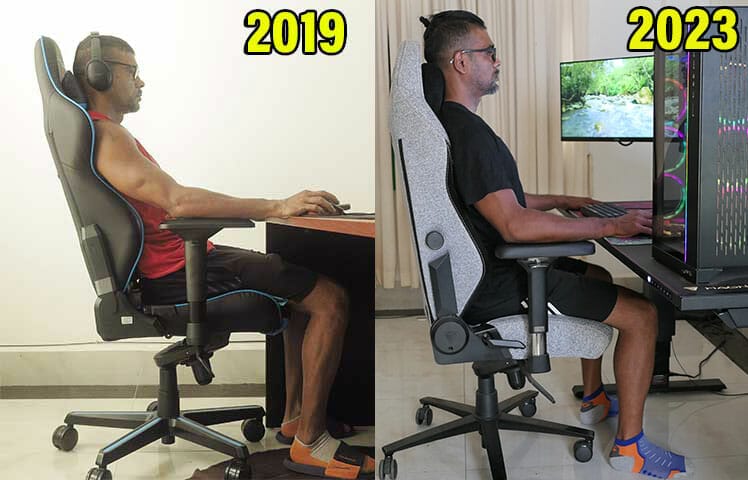
When sitting with a properly aligned spine, less energy is expended, leaving more for cognitive tasks(3).
Jump to section: how does neutral sitting boost brain power?
Movement is the best back pain treatment
Recent research and professional examples suggest movement as a far more effective solution for back pain than traditional medical interventions:
3. Ineffectiveness of medical treatments
A 2025 study in BMJ Evidence-Based Medicine(4) found that doctor-prescribed treatments for lower back pain are largely ineffective, with most offering only marginal relief compared to a placebo.
4. Healthy lifestyles over Medication
Instead of bunk medicine, many top esports and chess players prioritize 4 performance pillars: fitness, nutrition, rest, and mental balance.

Combined, these practices help to prevent back pain and enhance cognitive performance. Notably, ergonomic chairs play a very small role in the four pillars framework. With good habits, it’s entirely possible to thrive without a fancy chair.

As an example, Spaniard TheGrefg is one of the top Spanish streamers on Twitch, with over 12 million followers. He streams using cheap gaming chairs. However, because he maintains healthy habits, he thrives, despite the quality of his seating.
5. Evidence-based solutions
Several recent studies highlight the importance of movement and holistic health for back pain relief. Examples:
- Walking vs. Bed Rest: A 2024 Macquarie University study(5) found that an educational program combined with regular walking was more effective at preventing back pain than bed rest. Participants who walked regularly remained pain-free for nearly twice as long as the control group.
- Holistic Approach: A 2025 study in JAMA Network Open showed that integrating a better diet, physical activity, and stress management into a treatment plan significantly reduced disability and improved the quality of life for people with chronic back pain(6).
- Tai Chi Therapy: A Frontiers in Public Health review identified Tai Chi as a highly effective exercise for chronic lower back pain, with optimal results observed after three sessions per week for at least 16 weeks(7).
6. Best back strength exercises
Stronger back muscles make it easier to sit upright for longer periods. To promote good posture while competing, chess pro Magnus Carlsen combines core work with cardio. He often does balance exercises to strengthen his core muscles.
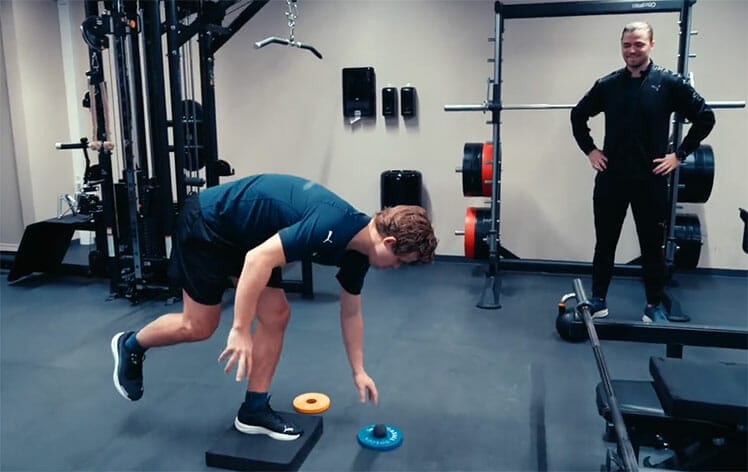
Here are ChairsFX, these beginner-friendly back exercises form the core of my back strength routine:
- Bodyweight pullups: This compound movement works your lats, biceps, shoulders, and core. It builds significant upper body pulling strength, while improving overall posture by strengthening the muscles that keep your shoulders from rounding.
- Dead hangs: Hanging from a pullup bar decompresses the spine, relieving pressure from long periods of sitting. It also builds powerful grip strength and stretches the lats and shoulders, which helps correct rounded posture.
- Hanging leg raises: Hang from a bar and raise your legs upward. This move builds core stability and strength, which is essential for maintaining an upright, solid posture. It also strengthens the hip flexors and engages the lower abs that support your lower back.
All you need is a pullup bar and a few minutes per day. If you struggle with poor posture and find it difficult to sit straight, this trio can yield remarkable progress in less than one month.
Ergonomic chairs support neutral postures
Ergonomic seating is just one part of the desk work wellness equation. All ergonomic chairs are designed to support a dynamic neutral posture. A textbook neutral posture includes a 0° neck tilt and a 25-45° lower back curve.
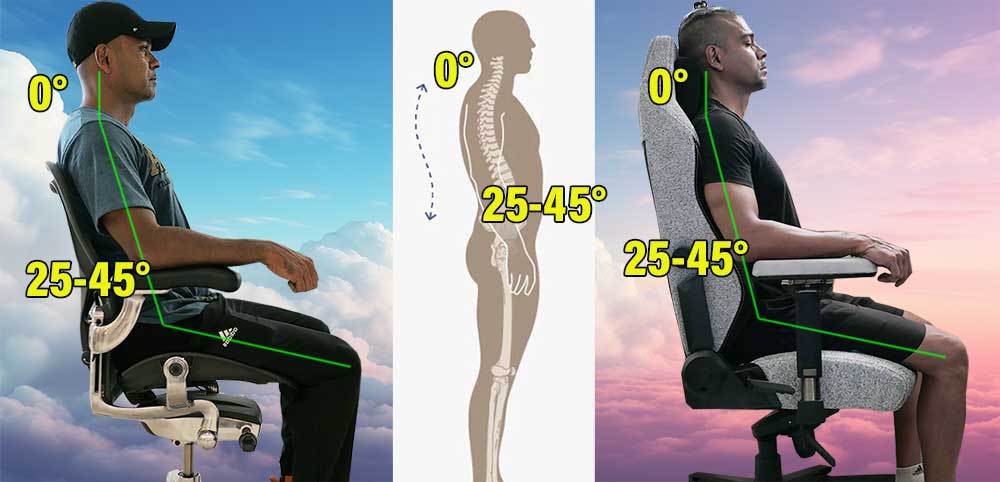
The problem: sitting in any fixed position for too long can strain neck and shoulder muscles, causing fatigue.
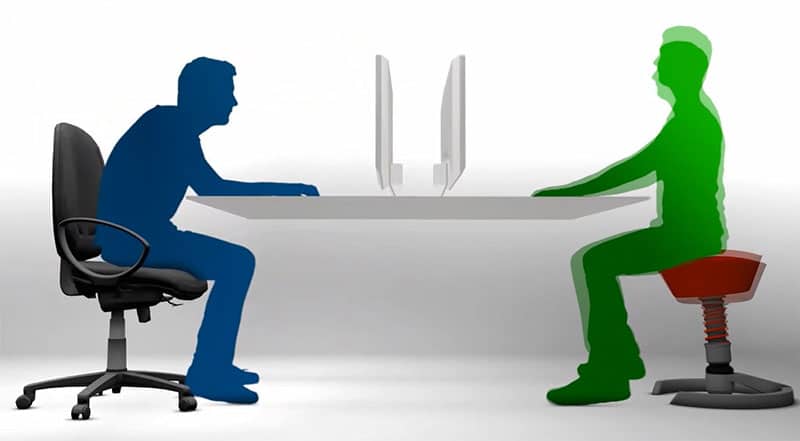
This is why many esports doctors emphasize frequent movement as more important than a perfect sitting posture for desk work performance.
Why good sitting posture still matters
The body adapts to the positions it holds most often. If you spend long periods slouching in a chair, chronic misalignments can set in.
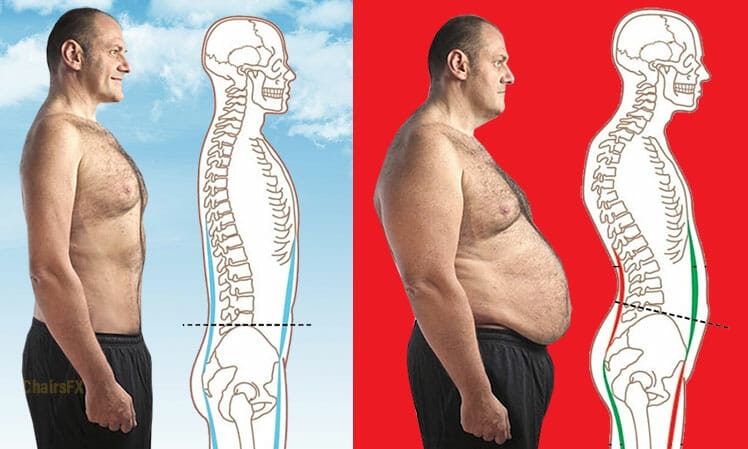
The solution: mix clean neutral postures with frequent position changes. Here at ChairsFX, I use clean neutral postures as my default.
After a few minutes of strict sitting, I relax, and sit however I feel like.
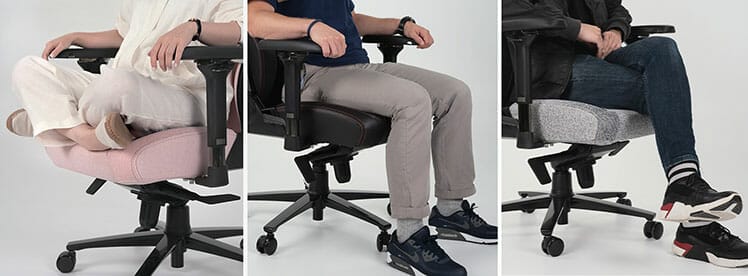
After a few minutes of casual freestyle, I’ll snap back into a clean neutral position. This routine preserves good posture muscle memories, making them easier to maintain over time.
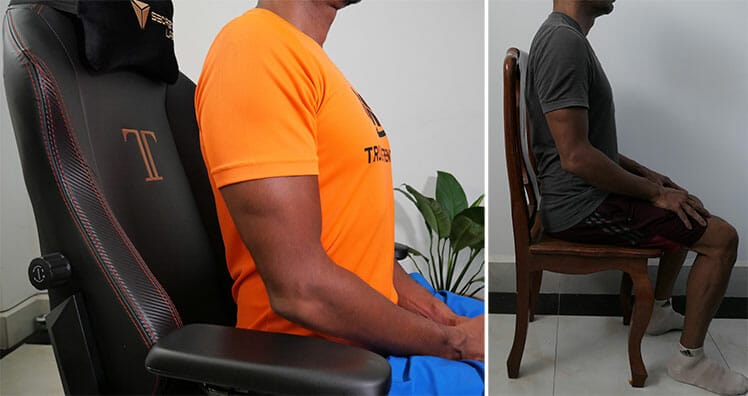
However, this routine alone is not enough for optimal health. Beyond sitting in dynamic neutral postures, you’ll need frequent walking breaks, exercise, proper nutrition, and sufficient sleep to sit for long periods with optimal health.
Key takeaway: any type of ergonomic office or gaming chair can promote wellness by supporting proper spinal alignment. However, its benefits are irrelevant without a holistic approach to desk work. This includes taking frequent breaks, exercising regularly, eating well, and getting sufficient sleep.
Ergonomic chair tilt functions are gimmicks
Don’t get fooled by the fancy tilt functions on high-priced ergonomic chairs. A 2013 systematic review found no evidence “to support the use of dynamic sitting approaches as an effective”.
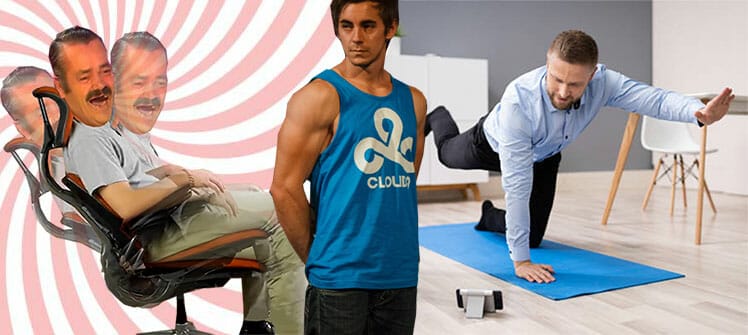
Instead, the review found that joint and muscle activity is affected more by standing and moving than by dynamic chair designs. Simply, the benefits of short movement and stretching breaks far outweigh those of fancy chair tilting functions.
Key takeaway: you can better support back health by taking frequent movement breaks, rather than flopping around in a chair.
ChairsFX picks: best ergonomic chairs
Dr. Jordan Tsai is a Doctor of Physical Therapy and member of Secretlab’s Ergonomics Advisory Board. Regarding the role of chairs for performance optimization, he advised ChairsFX readers:
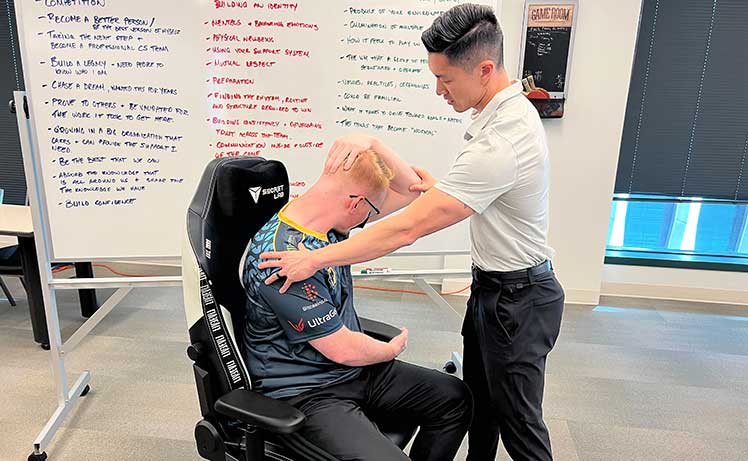
His concept, backed by science and esports performance principles, reframes the role of a chair:
- Musculoskeletal disorders (MSDs) are common.
- Posture influences energy and cognitive function.
- Movement is the most effective treatment for back pain.
- Ergonomic chairs support neutral postures; tilt functions are primarily marketing gimmicks.
A chair alone has minimal impact on desk work health. A good chair, used with neutral postures, is a small part of a larger system. Optimal back health, energy, and brain power come from combining chair-supported neutral postures with frequent breaks, exercise, healthy eating, and mental downtime.
Based on these factors (plus extensive testing of the world’s best gaming and office chairs), here are my picks for the best ergonomic desk chairs of 2025:
1. Herman Miller Aeron
- Best neutral posture support | $1805+ from Herman Miller
- Reference: #1 ranked office chair
Since 1994, the iconic Aeron has been revered for its ergonomic excellence, with neutral posture support as its primary function. What sets it apart is the 8Z Pellicle Mesh upholstery; its multiple tension zones guide users into balanced neutral postures, regardless of how they sit. The excellent posture support and long warranty justify the high price.
4.0 out of 5.0 stars4.0

- Concept: ultra-adaptive mesh that keeps a seated body perfectly balanced at all times
- Size rating: 3 sizes (A, B, C) support people 4’10” to 6’6″; 300 lbs
- Warranty: 12 years
Pros
- Very easy to use
- Best in class ultra-adaptive mesh upholstery
- Customizable builds (choose your style, lumbar support type, etc)
Cons
- Boring. The superb neutral posture support and 12-year warranty are the main selling points.
- The flashy Posturefit lumbar isn’t as effective as the simple lumbar slider.
- Hard plastic edges lining the seat can annoy your legs.
- The armrests are only 3D adjustable.
Learn more: Aeron Remastered Review | Aeron Gaming Chair Review.
Aeron from Herman Miller $1805+
The $1835 version includes: graphite frame; lumbar slider; tilt limiter + seat angle; 3D arms.
2. Secretlab Titan Evo
- Most versatile neutral posture support | $549-$674 from Secretlab
- Reference: Titan vs Aeron chair comparison
The Secretlab Titan Evo offers a headrest that supports a 0° neck posture, a feature not found on many chairs.
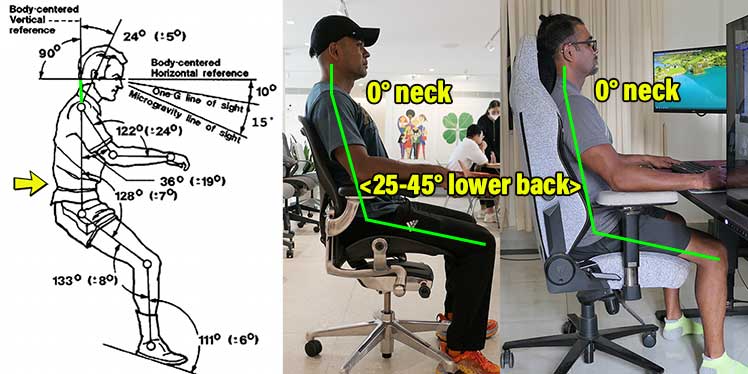
Combined with its industry-leading height x depth-adjustable lumbar support, cleverly-designed seat, and high-density padding, it provides biomechanically precise neutral posture support on par with the $1,200+ Aeron.
However, the Titan Evo is more versatile than the Aeron. Its design lets you relax, watch movies, or even nap comfortably.

When it’s time to focus, simply shift into a neutral posture. By aligning your spine, you energize your brain and amplify your focus for intense work sessions.
4.5 out of 5.0 stars4.5

- Concept: superb neutral posture support plus full freedom to move while you sit
- Size rating: small, medium, and XL options (see Titan sizing guide)
- Warranty: 5 years
Pros
- Best in class lumbar support, seat design, and armrests
- Supports biomechanically perfect neutral postures
- 50+ leatherette & fabric styles
- 5-year warranty
Cons
- The Titan allows for more sitting freedom than the Aeron. This means it’s easier to adopt poor sitting habits in the Titan without conscious effort, compared to the Aeron.
- The 65 kg/m³ padding provides superb stability, but some may find it too firm.
Titan EVO from Secretlab for $549-$674
Learn more: Titan Evo Chair Review
3. Steelcase Series 1
- Best affordable ergonomic office chair | Price not available on Amazon
- Reference: #1 ranked affordable office chair
For under $500, the Steelcase Series 1 delivers everything the $1,200 Aeron does, minus the high-end mesh. It has good height-adjustable lumbar support, 4D armrests, 3 tilt modes, a seat slider, and a 12-year warranty! The catch: its plain, no-frills design will bore thrill-seekers.
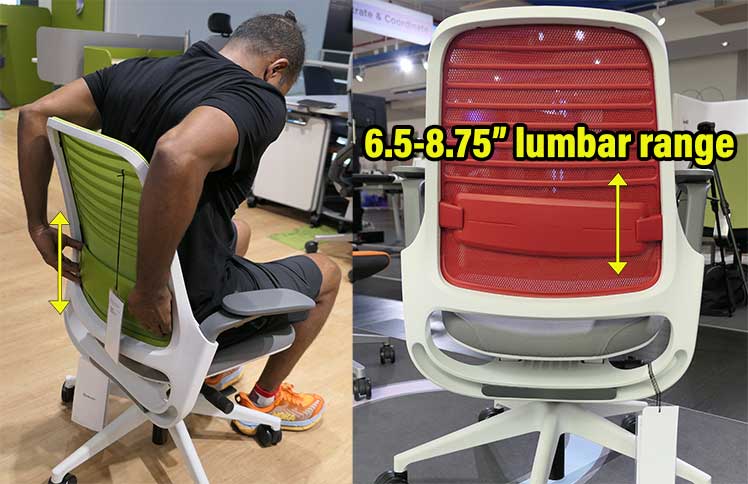
Given the price, warranty, and features, the Series 1 provides excellent value. It’s easy to use, durable, and effective – an excellent choice for those prioritizing function and affordability over style.
4.5 out of 5.0 stars4.5

- Features: 4D arms; height-adjustable lumbar support; 100-120° recline; 2° seat sync-tilt
- Seat: 19.2″ (W) x 15.75-18″ (adjustable D)
- Warranty: 12 years
Pros
- Solid build quality
- Excellent armrest adjustability
- 12-year warranty
- Very easy to use
Cons
- Only has three recline modes: 100°, 110°, and 120°
- Plain cubicle-style design
- Not as luxurious as pricier Steelcase chairs.
Series 1 on Amazon Price not available
Learn more: Healthy Sitting Quickstart For the Steelcase Series 1
4. Staples Hyken
Best cheap ergonomic office chair | $139.99 on Amazon
“Why pay more, when a $200 chair does the same job?” This was Techlead’s justification for choosing the Hyken as the best desk chair for programmers.
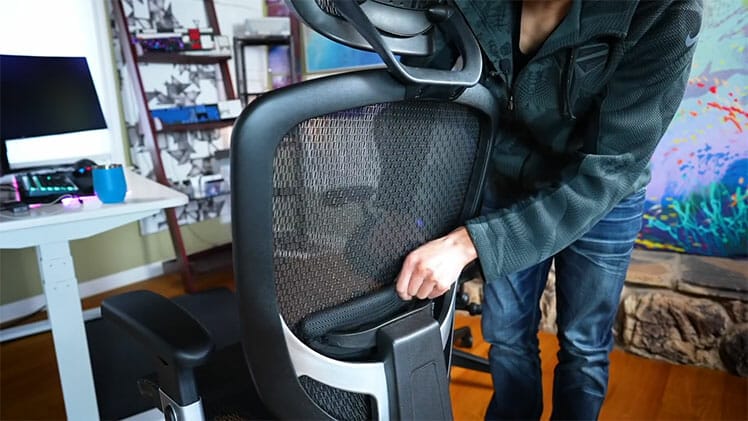
The only real downside is its flimsy build. If used full-time, expect the mesh to sag and parts to loosen within a year. If you can live with that, this is a solid starter chair for first-time ergo chair users.
4.0 out of 5.0 stars4.0

- Features: 1D arms; height-adjustable lumbar; 100-140° recline; full mesh upholstery
- Seat: 19.3″ (W) x 16.5″ (D)
- Warranty: 30-day return policy
- Size rating: 5’3″ to 5’10”, 250 lbs
Pros
- Full mesh upholstery
- Great adjustable features for the price
- Comes with a built-in 1° seat sync tilt
Cons
- Awkward headrest (remove it for best results)
- Its flimsy build wears down quickly if used full-time
Hyken Overview
The Staples Hyken delivers ergonomic basics for a rock-bottom price. With a height-adjustable lumbar, 100-140° recline, and cool, breathable mesh upholstery, it has everything you need to support good posture.
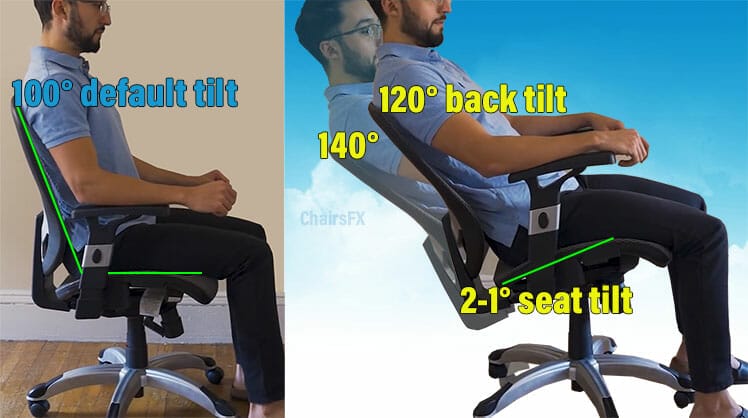
On the downside, its budget build quality won’t last long. With full-time use, expect the mesh to sag and components to loosen within a year.
Staples Hyken from Amazon $139.99
Learn more: Staples Hyken Office Chair Review
1st time ergo chair buyer FAQs
Should I buy a new chair to fix back pain?
If your existing ergonomic chair is causing you back pain, do not buy another chair! Instead, check your sitting form. Small adjustments can make a big difference.
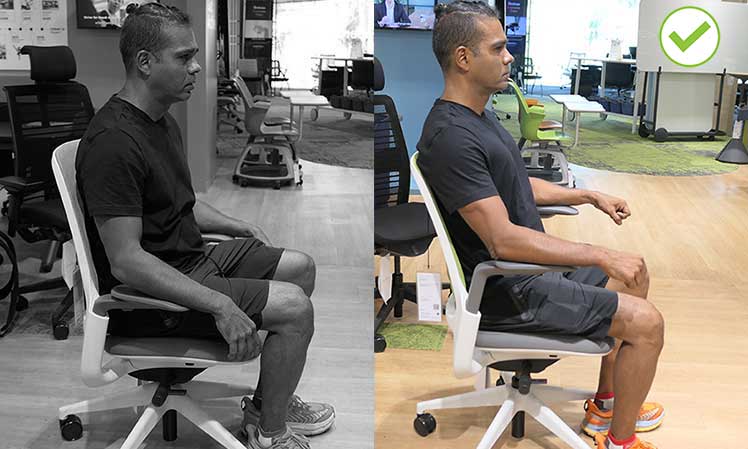
Doctor of Physical Therapy William Duncan has this advice for ChairsFX readers:
Instead of buying a new chair, he suggests assessing your current seated posture. Have a friend photograph you from the side while you sit.
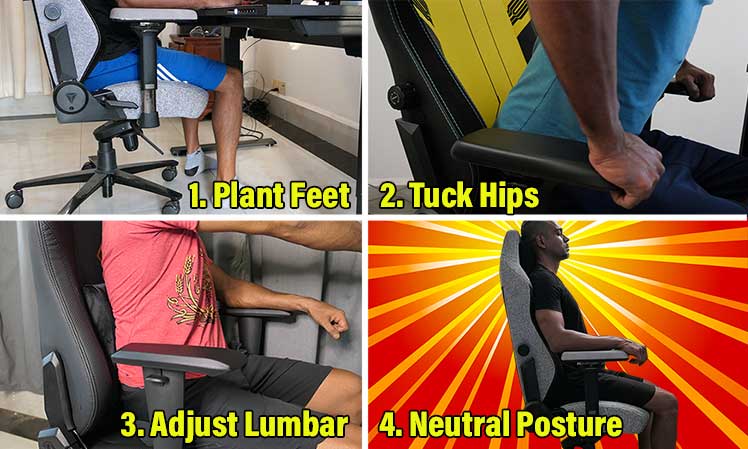
If you’re not sitting in a clean neutral posture, make adjustments. If you need help, read our Neutral Posture Starter’s Guide.
Then, spend a few days practicing. Once your muscle memories adjust, you should be able to relax pain-free – without wasting money on another chair.
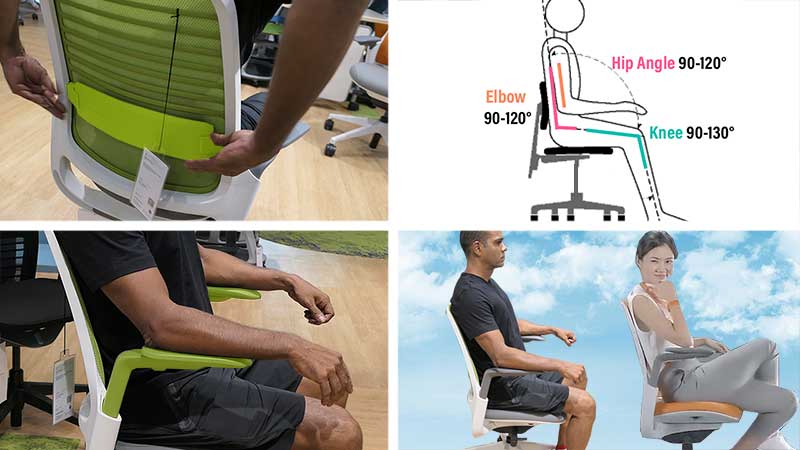
If you want professional help, take a side profile photo of your sitting posture. Then, find contact details for Dr. Duncan and two other esports doctors below. Send one of them your photo and ask for advice:
Are pricey ergonomic office chairs worth it?
Every fully ergonomic office chair supports neutral posture with three fundamental features: an adjustable lumbar support, adaptable armrests, and a reclining backrest.

For around $250, a well-made ergonomic chair can deliver solid posture support and comfort. So why pay upwards of $800 for a high-end model? It’s not about superior back support; it’s about luxury additions like premium materials, enhanced durability, and impressive aesthetics.
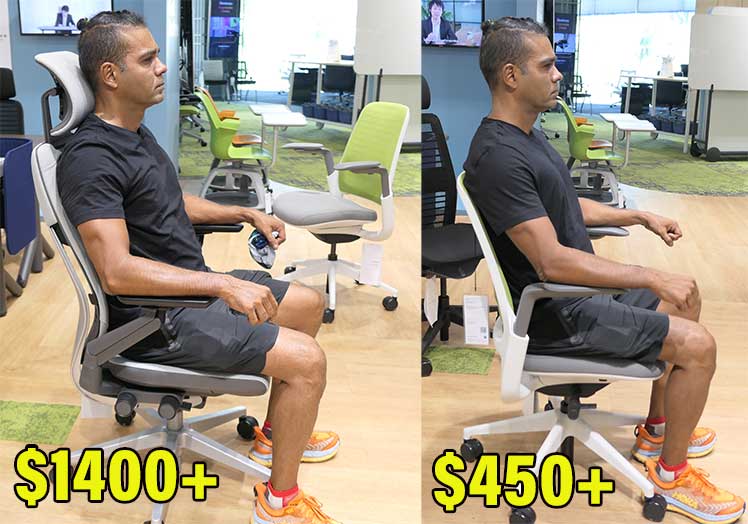
Buying a high-end chair is about investing in build quality and a 12-year warranty—features that deliver long-term peace of mind rather than groundbreaking ergonomic innovations.
While high-end models may also come with appealing extras, don’t expect “higher-tech” support. Instead, paying more means access to refined finishes, luxury materials, and options for custom configurations.

If you’re looking for dependable back support and don’t need luxury flourishes, an affordable ergonomic chair can do the job.
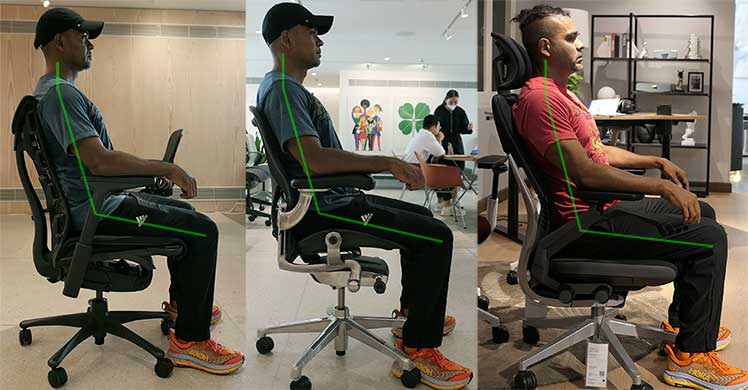
For those who prioritize quality craftsmanship and a more luxurious experience, check this review: Best high-end ergonomic office chairs of 2025.
How do standing desks help?
Standing desks offer a valuable way to break up prolonged sitting time, potentially reducing it by half. By spending part of the workday standing, you relieve some of the strain constant sitting can place on your spine, making it easier to maintain good posture during the times when you do sit.
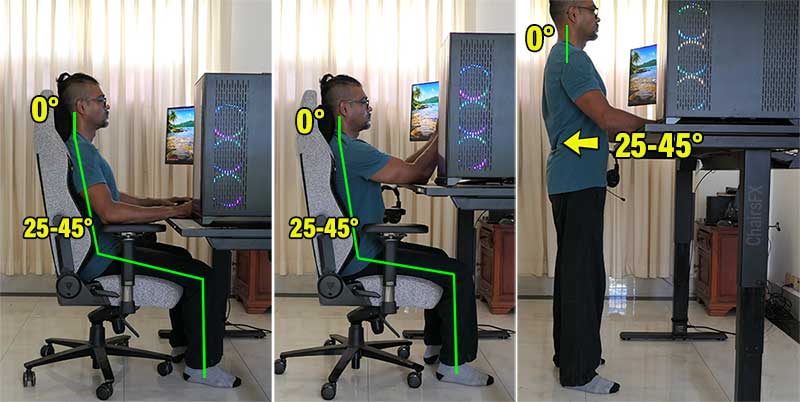
Additionally, a standing desk can help counteract “text neck,” which often results from poor mobile computing posture. By keeping your device at eye level while standing, you minimize neck strain and promote a more natural, ergonomic alignment.
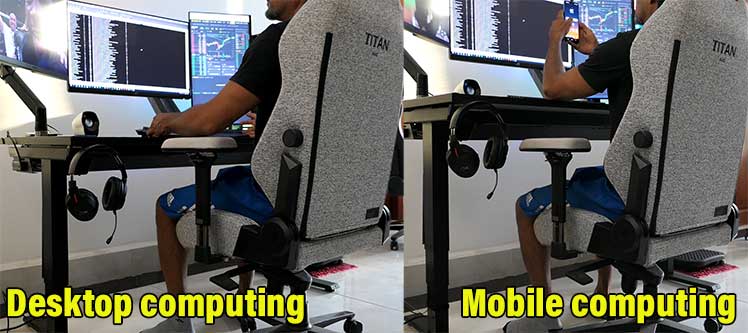
However, standing desks come with a learning curve. Achieving an effective balance between sitting and standing (ideally, a 1:1 ratio) requires discipline and a gradual adjustment period, as it may initially feel tiring to stand for long periods.
As you build stamina, alternating between sitting and standing can help improve posture and circulation, yet finding a rhythm that works for you may take time.
If a standing desk feels like a big commitment, taking short walking or stretching breaks every 15 minutes can offer similar benefits. Frequent movement helps offset the negative effects of prolonged sitting and can boost alertness and energy levels.
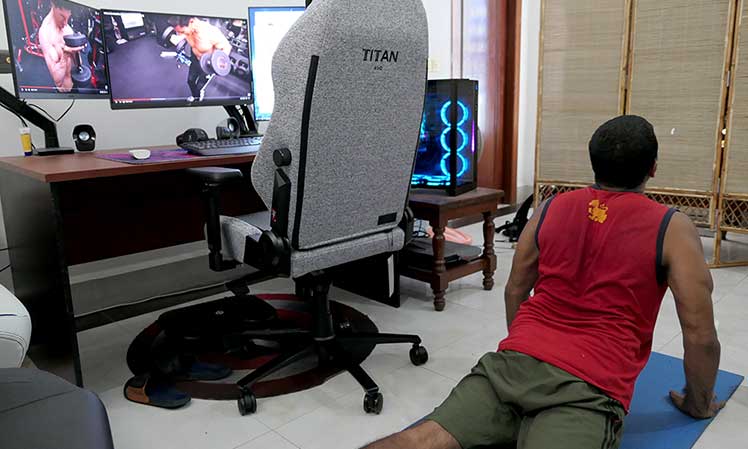
So, whether you choose a standing desk or prefer regular walking breaks, the key is to break up static postures to stay comfortable and energized throughout the day.
Standing Desk Pros & Cons Explained
Related: Magnus Pro Standing Desk Review
How do back exercises help?
Strengthening your back muscles can significantly enhance your ability to sit comfortably with good posture. When you sit at an ideal 100° recline, your body is well-supported but requires more muscle engagement to maintain neutral postures over time.

This setup can feel challenging initially, yet it presents a unique opportunity: building stronger back muscles helps you maintain upright posture for longer stretches, making sitting more comfortable and reducing strain on the spine.
Eager to embrace this, I worked with esports doctors who recommended a simple but effective back-strengthening routine. I began with bodyweight pull-ups, gradually progressing over 18 months to three sets of ten reps every other day.
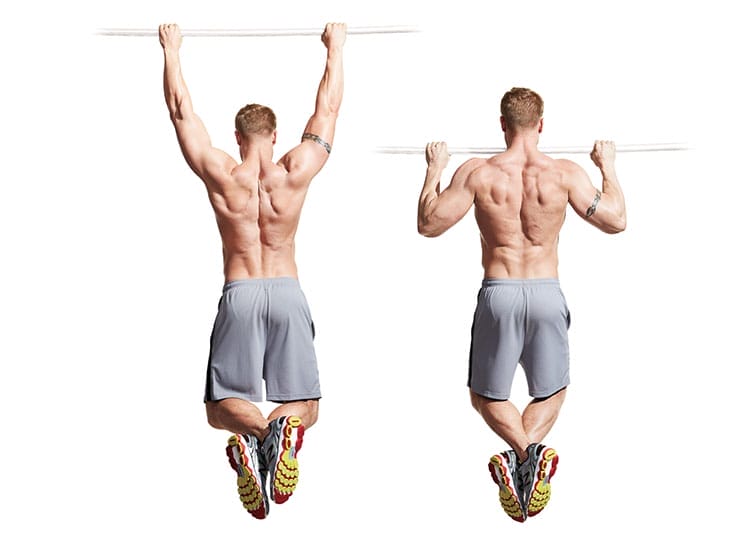
The impact was noticeable—sitting upright felt easier, and the visible strength gains were highly motivating.
How do ergo chairs boost brain power?
In my experience, the biggest benefit of properly using an ergonomic chair is the brain power boost. Sitting for long periods forces back muscles to work harder to hold the body upright. That burns energy reserves. As more power gets burned up by strained back muscles, less is available to the brain.
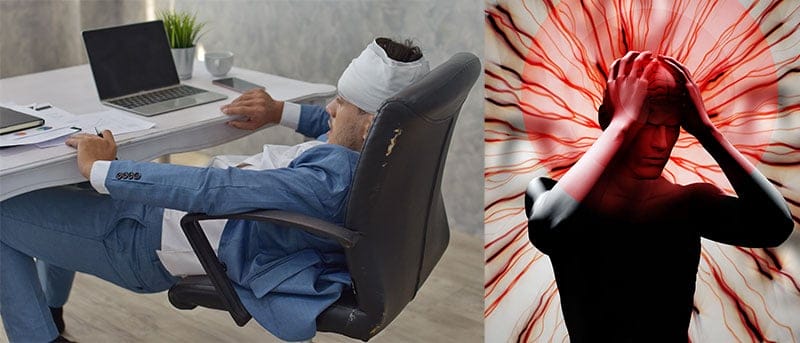
I found that one of the biggest benefits of sitting with good posture is the mental boost. With less sitting discomfort comes more energy and enhanced focus that’s noticeable.

My 2018 testimonial tells how learning neutral sitting taught me first-hand that good posture supercharges brain power while sitting at a desk.

In 2025 (seven years later), I still maintain neutral postures as my default while sitting. I’ve also made significant progress in all areas (desk work focus, fitness, diet, posture, stamina, back strength).
Conclusion: key takeaways
Like esports pros, desk workers can perform better by training like athletes. A chair alone is just a small part of the equation. Backed by science and the principles of esports performance, these desk work trends reframe the role of a chair:
- Musculoskeletal disorders (MSDs) are common.
- Posture influences energy and cognitive function.
- Movement is the most effective treatment for back pain.
- Ergonomic chairs support neutral postures; tilt functions are primarily marketing gimmicks.
No matter which chair you choose, remember to sit with a neutral posture, take frequent breaks, get regular exercise, eat well, and allow your mind time to rest.
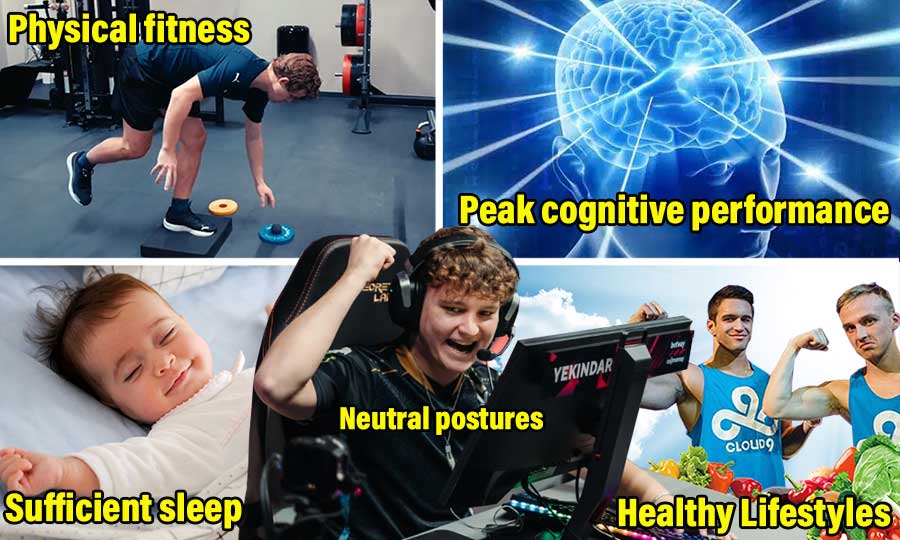
When you align all of these factors, you can expect superb back health, focused work bursts, and an enhanced quality of life.
4 Pillars of Esports Performance
Footnotes
- WHO Newsroom. ‘Musculoskeletal health’. July 14, 2022. https://www.who.int/news-room/fact-sheets/detail/musculoskeletal-conditions, (accessed 14 Sept. 2025).
- Professor Mark Hancock. ‘Walking to combat back pain: world-first study shows dramatic improvement’. The Lighthouse, June 2024. https://lighthouse.mq.edu.au/article/june-2024/walking-away-from-pain-world-first-study-shows-dramatic-improvement-in-lower-back-trouble, (accessed 14 Sept. 2025).
- Erik Peper, ‘Increase or Decrease Depression: How Body Postures Influence Your Energy Level’. Biofeedback 40(3):125-130, September 2012. DOI: 10.5298/1081-5937-40.3.01, (accessed 14 Sept. 2025).
- Aidan G Cashin, et al. ‘Analgesic effects of non-surgical and non-interventional treatments for low back pain’. BMJ Evidence-Based Medicine, March 18, 2025. https://ebm.bmj.com/content/30/4/222.info, (accessed 14 Sept. 2025).
- Natasha C Pocovi, PhD, et al. ‘Effectiveness and cost-effectiveness of an individualised, progressive walking and education intervention for the prevention of low back pain recurrence in Australia’. The Lancet, Volume 404, Issue 10488, P134-144, July 2024. https://www.thelancet.com/journals/lancet/article/PIIS0140-6736(24)00755-4/fulltext, (accessed 14 Sept. 2025).
- Emma Mudd, PhD, et al. ‘Healthy Lifestyle Care vs Guideline-Based Care for Low Back Pain’. JAMA Network Open, Volume 1, No. 1, Jan. 2025. DOI: 10.1001/jamanetworkopen.2024.53807, (accessed 14 Sept. 2025).
- Ke Zhao, et al. ‘Exercise prescription for improving chronic low back pain in adults: a network meta-analysis’. Frontiers in Public Health, Volume 13, May 2025. DOI: 10.3389/fpubh.2025.1512450, (accessed 14 Sept. 2025).



